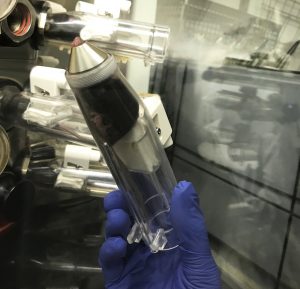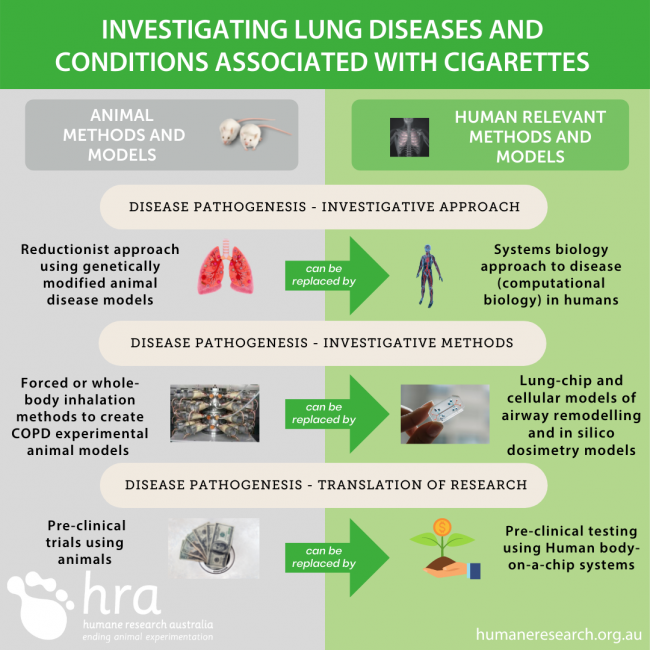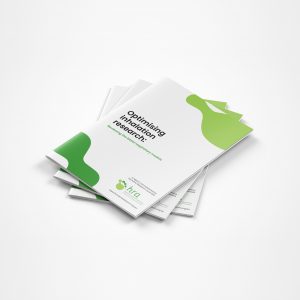Why are mice being forced to smoke?
In days past, you may have seen images of dogs with cones attached to their faces being forced to inhale cigarette smoke. However, sadly this is not a “thing of the past”. Today in Australia, mice are being used in inhalation studies. It is no less inhumane and carries the same ethical and scientific issues as using dogs.
Inhalation research is currently being conducted at institutions across Australia, with mice exposed via ‘nose only’ or ‘whole body’ exposure to cigarettes or other hazardous inhalants. The University of Newcastle has ceased the nose-only method but unfortunately this method continues to be used at Centenary Institute in Sydney. Animal models of diseases for which cigarette smoking has a correlation, such as chronic obstructive pulmonary diseases are created by researchers to investigate the basic biological mechanisms underlying respiratory disease in humans. However, these mechanisms are rarely the same between species. Researchers are also investigating local (lung) effects associated with toxicity of e-cigarettes.
To induce the disease, mice are subjected to up to 18 weeks of exposure to cigarette smoke. This is in addition to other procedures that may be carried out during the experiment, such as injections, the administration of food or drugs by force, behavioural tests, and ultimately death at the end of the experiment.
The nose only method (Centenary Institute) is illustrated below:

Multiple chambers are added to a smoking tower.

The whole body exposure is illustrated below:

Download Optimising inhalation research transitioning to human-relevant research
What is Animal-Free Science Advocacy doing to end forced smoking?
- Exposing smoke inhalation experimentation in Australia
- Educating the public at community forums and events
- Advertising and public awareness campaigns
- Lobbying policy-makers, regulators and politicians
- Producing scientific reports and educational resources
- Giving evidence at Parliamentary Inquiries
- Engaging with research institutes to transition to non-animal methods
- Submitting complaints to journal editors who publish nose-only research articles
Campaign Update
The National Health and Medical Research Council (NHMRC) has issued a policy statement and will no longer fund nose-only smoke inhalation research, as well as placing additional restrictions on whole-body exposure. Read our media release in response here.
Nose-only smoke exposure will be prohibited for new research projects in NSW. Read our media release here.
If you are a researcher seeking non-animal methods to use in place of this method, please contact our science outreach consultant Natalie Anderson via info@animalfreesci.org.au.
Animal-Free Science Advocacy Concerns
- This is highly invasive research, particularly nose-only smoke exposure, for a sustained period of time, from which the mice cannot escape. This kind of severe restraint causes significant stress to mice.
- There are additional animal welfare risks associated with the nose-only method such as the mice suffocating in the tube or complications due to faulty machines or human error. There are other unwanted impacts as well such as weight loss and hypothermia that the mice can experience while on the smoking tower.
- Mice may suffer from the painful conditions that are induced to recreate the human disease or condition
- Key anatomical differences between humans and rodents may impact inhalation data transferability
- The smoke inhalation model of COPD simply creates respiratory conditions which are indicative of inhalation toxicity, chronic stress, and lung injury rather than COPD and is an invalid method
- The smoking habits of humans are not represented in animal models
- There are more sophisticated human-based inhalation models available to provide results of greater human relevance
What could researchers be doing differently?
Drug development will not cease if forced inhalation research is prohibited. Promisingly, a systematic review of pharmacological models to investigate COPD drugs experimentally summarised that of all the models available (animal in vivo and in vitro, human in vitro and ex vivo), human ex vivo models were best to investigate antimuscarinic drugs for COPD. Particularly, ex vivo models using human isolated airways best represent the human condition for both stable and acute COPD and have been shown to translate to clinical trials.
Further suggested reading is an EU study which describes almost 300 non-animal models used for research on respiratory diseases and the development of new drugs and therapies.
Animal-Free Science Advocacy has commissioned a report to review the inhalation research currently being conducted at institutions in Australia, and how more sophisticated human-based models could be used to provide results of greater human relevance. Examples of these models include cell cultures and microphysiological systems, as well as human population studies and computational models.

Resources
Read Animal-Free Science Advocacy case studies profiling smoking mice research at:
UTS, Sydney:
https://animalfreescienceadvocacy.org.au/mice-forced-to-inhale-e-cigaratte-vapour-during-pregnancy/
RMIT, Melbourne:
https://animalfreescienceadvocacy.org.au/cigarette-smoking-and-stroke-induced-in-mice/
Recent publications using nose-only method at Centenary Institute:
Adverse roles of mast cell chymase-1 in COPD
RIPK1 kinase-dependent inflammation and cell death contribute to the pathogenesis of COPD
Read a case study of non-animal research assessing how e-cigarettes impact airway cells. See a case study into human-relevant COPD research.
Read our media release announcing our report release here.
Listen to our podcast episodes detailing the research conducted and the ethical implications.


